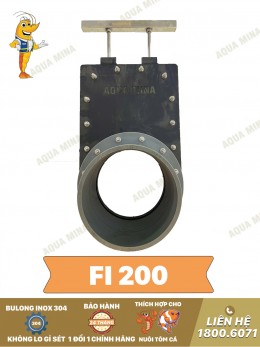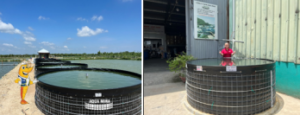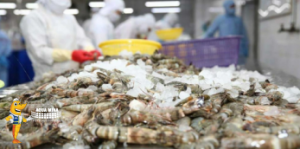Sharing the Use of Probiotics in Shrimp Farming to Increase Success Rates
This question involves two key parts:
Is using probiotics in shrimp farming effective in increasing success rates?
How to apply probiotics—whether by dispersing them into the water, adding them to feed, or using other methods for optimal results?
Let’s explore the answers below.
Is Using Probiotics in Shrimp Farming Effective?
Answer:
Yes, using probiotics in shrimp farming effectively increases success rates. Probiotics, also known as biological products, act as a tool to prevent and combat harmful bacteria that cause diseases in shrimp.
Disease outbreaks are a significant reason for failures in farming, and shrimp farming is no exception. Shrimp are susceptible to various diseases, with bacterial infections being the primary cause of rapid, mass mortality.

Harmful bacteria invade shrimp through two main pathways:
Through the digestive tract: Bacteria attach to feed consumed by shrimp, enter the intestines, and colonize the gut, causing damage. These bacteria can also spread to the shrimp's hepatopancreas, a critical organ responsible for digestion and growth, leading to severe harm or death.
Through the gills: Bacteria can invade the shrimp through the gills, leading to rapid death.
To counteract these threats, scientists have developed probiotics and biological products to:
Treat water by eliminating harmful bacteria.
Enhance shrimp health when mixed with their feed.
Key Tips for Effective Use of Probiotics
Select High-Quality Products:
Choose probiotics with clear labeling, proper certifications, and traceable origins. Ensure you gather sufficient information before purchasing, as probiotics will be used consistently throughout the farming cycle.
Learn from Experienced Farmers:
Seek advice from seasoned shrimp farmers on how to effectively use probiotics.
Experiment and Adapt:
Monitor water quality, shrimp health, and gut conditions to develop your own effective methods.
Proper Application of Probiotics for Shrimp Farming
Understanding the Two Bacterial Groups in Shrimp Farming:
Harmful bacteria (Group H): These grow and reproduce rapidly, often dominating the environment.
Beneficial bacteria (Group B): These grow slower but are vital for a healthy ecosystem.
Without intervention, harmful bacteria quickly outnumber beneficial ones, creating an unhealthy environment. To prevent this, follow these steps:
Thorough Pond Preparation:
Clean organic waste and sludge from the pond.
Regularly siphon the pond bottom and manage feed waste to reduce harmful bacteria growth.
Timing of Probiotic Use:
Apply probiotics 48–72 hours after disinfection (depending on the chemical used and its recommended dosage).
Use higher doses than labeled (up to double) for 2–5 consecutive days before stocking shrimp.
Continuous Application:
During the first month: Apply probiotics daily.
In subsequent months: Use probiotics every 2–4 days, adjusting based on water quality and bacterial analysis.
Compensate for Water Changes:
Water exchanges may wash away beneficial bacteria. Always reapply probiotics after changing water to maintain a balanced microbial environment.
Improve Shrimp Gut Health:
Mix probiotics into feed from the first feeding session. Continue daily, ensuring at least one feeding includes probiotics even when mixing antibiotics or other supplements.
By creating a beneficial microbial environment in both the pond and the shrimp's gut, you can significantly reduce disease risks and improve farming outcomes.
Contact AQUA MINA for consultation and supply of aquaculture round tanks and aquaculture equipment for high-tech shrimp farming.
- Address: 685 National Highway 1A, Binh Hung Hoa Ward, Binh Tan District, Ho Chi Minh City
- Phone: 1800 6071 (Toll-free hotline)
- Email: sales@aquamina.com.vn or oversea@aquamina.com.vn
Aqua Mina's distributor in Japan:
REX INDUSTRIES CO., LTD
- Address: 1-9-3 Hishiya-Higashi, Higashi-Osaka 578-0948 JAPAN
- Email: kimakubo@rexind.co.jp
- Phone: +81-(0)72-961-9893
- Website: http://www.rexind.co.jp/e/

Ngày đăng : 23/11/2024
2222 View
Other Articles
Cà Mau strengthens traceability to enhance the competitiveness of the shrimp industry.
Cold stress: Effects on the plasma characteristics of whiteleg shrimp.
A new breakthrough in the prevention of diseases caused by the microsporidian parasite EHP in shrimp farming
Vietnam’s shrimp export outlook in the first quarter of 2026 continues to face heavy pressure from tariffs.
New England’s shrimp fishery to shut down for the long haul after years of decline
Crab exports to the United States account for more than 80%.
Thailand sets a target to increase shrimp production to 400,000 tons by 2026.
CTU-RAS: Recirculating Shrimp Farming for Sustainable Development
Vietnamese aquatic products reach new markets
Global Shrimp Forum: Global shrimp trade is reshaping
China’s Import Value Up 10%, Vietnamese Shrimp Remains Among Leading Suppliers
After the 7.5-magnitude offshore earthquake in Aomori that injured 34 people, Japan has issued a warning about a potential mega-earthquake



















.jpg)